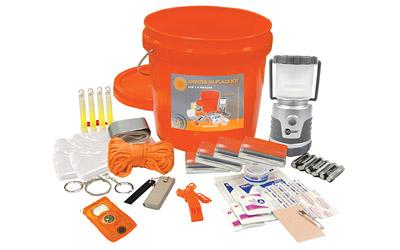The First Priority of Survival
November 25 2017
As long as we have oxygen shelter and protection from the elements is our biggest priority in a survival situation. In extreme conditions; perhaps a fall into freezing water or being outside without proper winter clothing in very cold conditions, you have literally only minutes before you are incapacitated to the point of being unable to care for yourself. In these situations there is a very real possibility that you will die!
So how do we provide that shelter and protection that we need?
Getting out of the cold is the first priority, out of the water you have fallen into or out of the wind or cold as best as you can. You may need to drag yourself out of an icy stream or lake which is a difficult task on it’s own. If you are wet you will need to get out of those wet clothes, you will dry quicker without clothing and while your clothes are wet they are providing little or no insulation. Some modern synthetic fibres do provide some insulation when wet but as a rule get out of your wet clothes. Keep moving and keep your temperature up. Try to dry your clothes as best you can by lighting a fire, this will help you warm up and get dry too and the work you will have to put into getting your fire going should help stay warm as well. Once you have dried out you can start thinking about more permanent shelter.
Under less dire circumstances your shelter priorities can be slightly different. Whenever I am on expedition putting up my shelter, whether that’s a tent or a bivi, is always my first priority. It gives you somewhere to store your equipment and keep your kit dry while you start a fire or make any other camp site preparations. Whatever shelter solution you go for it needs to keep you out of the rain and wind and be relatively quick to erect. This might be difficult if you are planning to use very specialist shelters such as traditional wall tents or specialist geodesic dome tents for extreme conditions. Lighter weight shelter options are often the best choice for survival and general outdoor pursuits.
One of the lightest weight solutions for shelter is to carry a tube tent, these are small enough to easily fit in a small survival kit or include in a bug out bag without adding any significant extra weight. They are also very easy to pitch between trees or between two ski poles or sticks. If you require a little more versatility from your shelter then a flat tarp is another option, the advantage with these is that they can be pitched at any height above the ground to provide a very tight low profile shelter to a larger configuration which gives room to stand and move about. The other advantage of these tarps is that they can be used to drag things with as long as they are heavy duty enough, dragging loads of firewood or a deer carcass from a successful hunt or a casualty for evacuation is much easier than having to carry such a heavy load.
Remember that on occasion you may not be somewhere that you have what you need to pitch a tarp or tube tent, perhaps on expeditions in the desert, above the tree line or in arctic areas you will find very few trees to use for pitching you shelter so consider something self-supporting such as a tent.
Also for emergencies consider a comprehensive kit which includes other shelter necessities such as lights, additional guy ropes for securing your shelter and the bug out bag staple mylar survival blankets. These items are so small and light that they can be carried in a pocket on a daily basis or stuffed into a first aid kit and they should be, these small things are what is really going to save you in an emergency.
Recents Posts
September 26 2018
Train Like You Fight with a Good Set of Ear Plugs
July 04 2018
A Holster by Any Other Name is Still a Holster
June 03 2018
DNA Tactical Self-Defense Tools
May 15 2018
A Guide to Handgun Holsters
April 19 2018
Waistband v. Shoulder v. Ankle: The Great Holster Debate
April 05 2018
Essential Gear Components for Disaster Survival
March 22 2018
Protecting Your Eyes on the Range is Plain Common Sense
January 24 2018
Customize Your Gear to Win the Fight of Your Life
January 19 2018
How to Choose A Hand-Held Light
January 11 2018
How to Choose a Hands-Free Light
January 08 2018
The Right Holster for Everyday Carry? You are Your Own Expert
December 11 2017
Emergency Outdoors Medicine and Rescue
December 10 2017
Cordage and Accessories for Survival and Outdoors
December 03 2017
Choosing and Using Survival Knives
November 19 2017
Water, Water Everywhere but Not a Drop to Drink
